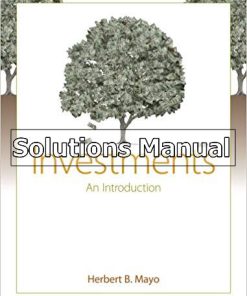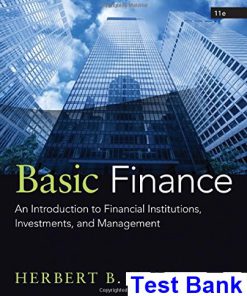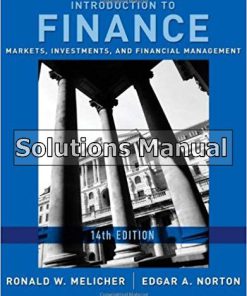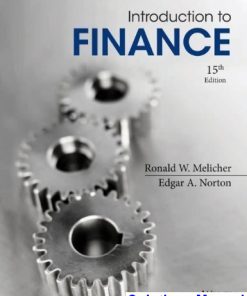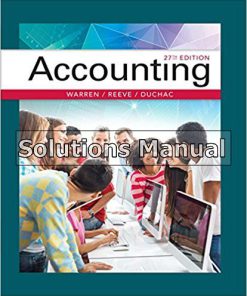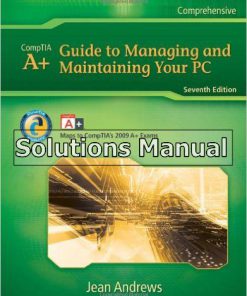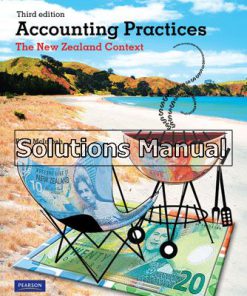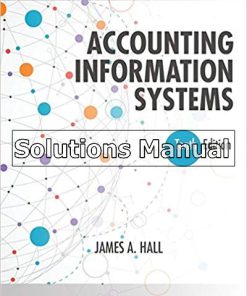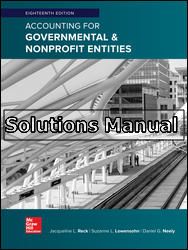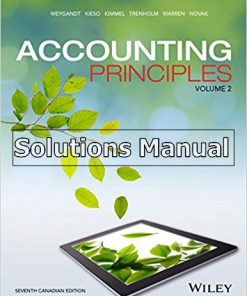Basic Finance An Introduction to Financial Institutions Investments and Management 11th Edition Mayo Solutions Manual
$50.00 Original price was: $50.00.$26.50Current price is: $26.50.
Basic Finance An Introduction to Financial Institutions Investments and Management 11th Edition Mayo Solutions Manual.
This is completed downloadable of Basic Finance An Introduction to Financial Institutions Investments and Management 11th Edition Mayo Solutions Manual
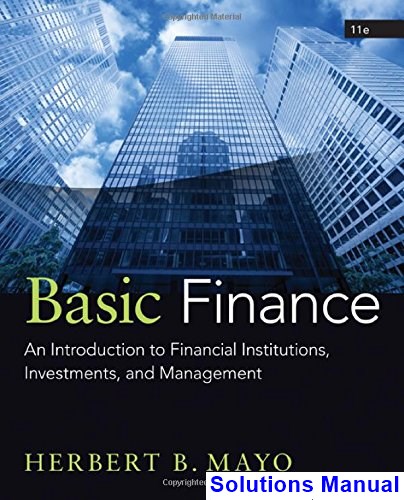
Product Details:
ISBN-13: 978-1285425795
Author: Herbert B. Mayo
Combining current coverage with a student-friendly modular format, BASIC FINANCE: AN INTRODUCTION TO FINANCIAL INSTITUTIONS, INVESTMENTS & MANAGEMENT, 11E introduces the three primary aspects of finance and examines how they are interrelated to give students a firm foundation in all of finance–not just corporate finance. Each chapter offers a concise, self-contained treatment of one or two finance concepts, or institutions easily covered in a single class period. Students can build on what they learn through the text’s Internet resources, number problems, illustrations using financial calculators, and a Microsoft Excel appendix. The time value of money is emphasized throughout. The 11th Edition includes numerous self-help problems with answers and relationships with answers, new coverage of classes of stock/preferred stock, new sections on Internet sources of information, and updated tax laws.
Table of Content:
- Ch 1: An Introduction to Basic Finance
- Ch 1: Introduction
- 1.1: The Divisions of Finance
- 1.2: Key Financial Concepts
- 1.3: Assumptions
- 1.4: Finance and Other Business Disciplines
- 1.5: Plan of the Text
- 1.6: Relationships
- Part 1: Financial Institutions
- Ch 2: The Role of Financial Markets and Financial Intermediaries
- Ch 2: Introduction
- 2.1: The Role of Money
- 2.2: The Role of Interest Rates
- 2.3: Financial Markets and the Transfer of Savings
- 2.4: The Indirect Transfer Through Financial Intermediaries
- 2.5: Commercial Banks
- 2.6: Thrift Institutions
- 2.7: Regulation of Commercial Banks and Thrift Institutions
- 2.8: Life Insurance Companies
- 2.9: Pension Plans
- 2.10: Money Market Mutual Funds and Money Market Instruments
- 2.11: Competition for Funds
- Ch 2: Summary
- Ch 2: Review Objectives
- Ch 2: Relationships
- Ch 2: Answers
- Ch 3: Investment Banking
- Ch 3: Introduction
- 3.1: The Transfer of Funds to Business
- 3.2: The Role of Investment Bankers
- 3.3: Volatility of the Market for Initial Public Offerings
- 3.4: Shelf Registrations
- 3.5: The Regulation of New Public Issues of Corporate Securities
- 3.6: Sarbanes-Oxley Act of 2002
- Ch 3: Summary
- Ch 3: Review Objectives
- Ch 3: Internet Assignment
- Ch 4: Securities Markets
- Ch 4: Introduction
- 4.1: Market Makers
- 4.2: The Mechanics of Investing in Securities
- 4.3: The Short Sale
- 4.4: Measures of Securities Prices
- 4.5: Foreign Securities
- 4.6: Competition in the Securities Markets
- Ch 4: Summary
- Ch 4: Review Objectives
- Ch 4: Internet Assignment
- Ch 4: Problems
- Ch 4: Additional Problems with Answers
- Ch 4: Answers
- Ch 4: Relationships
- Ch 4a: Answers
- Ch 5: The Federal Reserve
- Ch 5: Introduction
- 5.1: The Role of the Federal Reserve
- 5.2: Structure of the Federal Reserve
- 5.3: The Expansion of Money and Credit
- 5.4: The Tools of Monetary Policy
- 5.5: The Impact of Fiscal Policy on Credit Markets
- 5.6: Impact of an Inflationary Economic Environment on Credit Markets
- Ch 5: Summary
- Ch 5: Review Objectives
- Ch 5: Internet Assignments
- Ch 5: Relationships
- Ch 5: Answers
- Ch 6: International Currency Flows
- Ch 6: Introduction
- 6.1: Foreign Currencies and the Rate of Exchange
- 6.2: Balance of Payments
- 6.3: The Role of the International Monetary Fund
- Ch 6: Summary
- Ch 6: Review Objectives
- Ch 6: Problems
- Ch 6: Additional Problems with Answers
- Ch 6: Answers
- Ch 6: Relationships
- Ch 6a: Answers
- Part 2: Financial Tools
- Ch 7: The Time Value of Money
- Ch 7: Introduction
- 7.1: The Future Value of a Dollar
- 7.2: Solving Time Value Problems Using Financial Calculators
- 7.3: The Present Value of a Dollar
- 7.4: The Future Value of an Annuity of a Dollar
- 7.5: The Present Value of an Annuity of a Dollar
- 7.6: Illustrations of Compounding and Discounting
- 7.7: Nonannual Compounding
- Ch 7: Summary
- Ch 7: Summary of the Equations for the Interest Factors
- Ch 7: Review Objectives
- Ch 7: Problems
- Ch 7: Additional Problems with Answers
- Ch 7: Answers
- Ch 7: Relationships
- Ch 7a: Answers
- Ch 8: Risk and Its Measurement
- Ch 8: Introduction
- 8.1: The Return on an Investment
- 8.2: The Sources of Risk
- 8.3: The Standard Deviation as a Measure of Risk
- 8.4: Risk Reduction Through Diversification—An Illustration
- 8.5: Beta Coefficients
- 8.6: Regression Analysis and the Estimation of Beta Coefficients
- 8.7: The Capital Asset Pricing Model and an Investment’s Required Return
- Ch 8: Summary
- Ch 8: Review Objectives
- Ch 8: Internet Assignments
- Ch 8: Problems
- Ch 8: Additional Problems with Answers
- Ch 8: Answers
- Ch 8: Relationships
- Ch 8a: Answers
- Ch 9: Analysis of Financial Statements
- Ch 9: Introduction
- 9.1: General Accounting Principles
- 9.2: The Balance Sheet
- 9.3: The Income Statement
- 9.4: Statement of Cash Flows
- 9.5: Limitations of Accounting Data
- 9.6: Depreciation
- 9.7: Ratio Analysis of Financial Statements
- 9.8: Liquidity Ratios
- 9.9: Activity Ratios
- 9.10: Profitability Ratios
- 9.11: Leverage Ratios
- 9.12: Coverage Ratios
- 9.13: Analysis of Financial Statements and the Internet
- Ch 9: Summary
- Ch 9: Review Objectives
- Ch 9: Internet Assignment
- Ch 9: Problems
- Ch 9: Additional Problem with Answers
- Ch 9: Answers
- Ch 9: Relationships
- Ch 9a: Answers
- Part 3: Investments
- Ch 10: The Features of Stock
- Ch 10: Introduction
- 10.1: Equity
- 10.2: Common Stock
- 10.3: Dividend Policy
- 10.4: Cash Dividends
- 10.5: Stock Dividends
- 10.6: Stock Splits
- 10.7: Dividend Reinvestment Plans
- 10.8: Repurchase of Stock
- Ch 10: Summary
- Ch 10: Review Objectives
- Ch 10: Internet Assignments
- Ch 10: Problems
- Ch 10: Additional Problems with Answers
- Ch 10: Answers
- Ch 10: Relationships
- Ch 10a: Answers
- Ch 11: Stock Valuation
- Ch 11: Introduction
- 11.1: Valuation of Common Stock: The Present Value and the Growth of Dividends
- 11.2: Risk and Stock Valuation
- 11.3: Alternative Valuation Techniques: Multiplier Models
- 11.4: Stock Valuation and a Word of Caution
- Ch 11: Summary
- Ch 11: Review Objectives
- Ch 11: Internet Assignments
- Ch 11: Problems
- Ch 11: Additional Problems with Answers
- Ch 11: Answers
- Ch 11: Relationships
- Ch 11a: Answers
- Ch 12: The Features of Long-Term Debt—Bonds
- Ch 12: Introduction
- 12.1: Characteristics of All Debt Instruments
- 12.2: Types of Corporate Bonds
- 12.3: Foreign Bonds
- 12.4: Registered and Book Entry Bonds
- 12.5: Retiring Debt
- 12.6: Government Securities
- 12.7: Obtaining Information on Bonds
- Ch 12: Summary
- Ch 12: Review Objectives
- Ch 12: Relationships
- Ch 12: Answers
- Ch 13: Bond Pricing and Yields
- Ch 13: Introduction
- 13.1: Bond Pricing
- 13.2: Yields
- Ch 13: Summary
- Ch 13: Review Objectives
- Ch 13: Problems
- Ch 13: Additional Problems with Answers
- Ch 13: Answers
- Ch 13: Relationships
- Ch 13a: Answers
- Ch 14: Preferred Stock
- Ch 14: Introduction
- 14.1: The Features of Preferred Stock
- 14.2: Preferred Stock and Bonds Contrasted
- 14.3: Valuation (Pricing) of Preferred Stock
- 14.4: Analysis of Preferred Stock
- 14.5: Disadvantages of Preferred Stock from an Investor’s Perspective
- Ch 14: Summary
- Ch 14: Review Objectives
- Ch 14: Problems
- Ch 14: Additional Problems with Answers
- Ch 14: Answers
- Ch 14: Relationships
- Ch 14a: Answers
- Ch 15: Convertible Securities
- Ch 15: Introduction
- 15.1: Features of Convertible Bonds
- 15.2: The Valuation of Convertible Bonds
- 15.3: Premiums Paid for Convertible Debt
- 15.4: Convertible Preferred Stock
- 15.5: Calling Convertibles and Investment Returns
- Ch 15: Summary
- Ch 15: Review Objectives
- Ch 15: Problems
- Ch 15: Additional Problems with Answers
- Ch 15: Answers
- Ch 15: Relationships
- Ch 15a: Answers
- Ch 16: Investment Returns
- Ch 16: Introduction
- 16.1: The Computation of Returns
- 16.2: Historical Investment Returns
- Ch 16: Summary
- Ch 16: Review Objectives
- Ch 16: Problems
- Ch 16: Additional Problems with Answers
- Ch 16: Answers
- Ch 16: Relationships
- Ch 16a: Answers
- Ch 17: Investment Companies
- Ch 17: Introduction
- 17.1: Investment Companies: Origins and Terminology
- 17.2: Closed-End Investment Companies
- 17.3: Sources of Return from Investing in Closed-End Investment Companies
- 17.4: Mutual Funds
- 17.5: The Portfolios of Mutual Funds
- 17.6: The Portfolios of Specialized Mutual Funds
- 17.7: The Returns Earned on Investments in Mutual Funds
- 17.8: Selecting a Mutual Fund
- 17.9: Exchange-Traded Funds (ETFs)
- Ch 17: Summary
- Ch 17: Review Objectives
- Ch 17: Internet Assignments
- Ch 17: Problems
- Ch 17: Additional Problems with Answers
- Ch 17: Answers
- Ch 17: Relationships
- Ch 17a: Answers
- Part 4: Corporate Finance
- Ch 18: Forms of Business and Corporate Taxation
- Ch 18: Introduction
- 18.1: The Three Components of Financial Management
- 18.2: Sole Proprietorships, Partnerships, and Corporations
- 18.3: Corporate Taxation
- 18.4: Taxation of Corporate Losses
- Ch 18: Summary
- Ch 18: Review Objectives
- Ch 18: Problems
- Ch 18: Additional Problems with Answers
- Ch 18: Answers
- Ch 18: Relationships
- Ch 18a: Answers
- Ch 19: Break-Even Analysis and the Payback Period
- Ch 19: Introduction
- 19.1: Break-Even Analysis
- 19.2: The Payback Period
- Ch 19: Summary
- Ch 19: Review Objectives
- Ch 19: Problems
- Ch 19: Additional Problems with Answers
- Ch 19: Answers
- Ch 19: Relationships
- Ch 19a: Answers
- Ch 20: Leverage
- Ch 20: Introduction
- 20.1: Operating Leverage
- 20.2: Operating Leverage and Risk
- 20.3: Financial Leverage
- 20.4: Financial Leverage and Risk
- 20.5: Financial Leverage Through Preferred Stock Financing
- Ch 20: Summary
- Ch 20: Review Objectives
- Ch 20: Problems
- Ch 20: Additional Problems with Answers
- Ch 20: Answers
- Ch 20: Relationships
- Ch 20a: Answers
- Ch 21: Cost of Capital
- Ch 21: Introduction
- 21.1: Components of the Cost of Capital
- 21.2: Cost of Capital: A Weighted Average
- 21.3: The Optimal Capital Structure
- 21.4: The Marginal Cost of Capital
- 21.5: The Optimal Capital Structure and the Value of the Firm’s Stock
- 21.6: Cost of Capital: Review and Problem Areas
- Ch 21: Summary
- Ch 21: Review Objectives
- Ch 21: Problems
- Ch 21: Additional Problems with Answers
- Ch 21: Answers
- Ch 21: Relationships
- Ch 21a: Answers
- Ch 22: Capital Budgeting
- Ch 22: Introduction
- 22.1: Valuation and Long-Term Investment Decisions
- 22.2: Importance of Cash Flow
- 22.3: Introduction to Discounted Cash Flow Methods of Capital Budgeting
- 22.4: Net Present Value
- 22.5: Internal Rate of Return
- 22.6: Net Present Value and Internal Rate of Return Compared
- 22.7: Ranking Investment Alternatives
- 22.8: The Introduction of Risk into Capital Budgeting
- 22.9: Risk Adjustments in Capital Budgeting
- Ch 22: Summary
- Ch 22: Review Objectives
- Ch 22: Problems
- Ch 22: Additional Problems with Answers
- Ch 22: Answers
- Ch 22: Relationships
- Ch 22a: Answers
- Ch 23: Forecasting
- Ch 23: Introduction
- 23.1: Planning
- 23.2: Fluctuations in Asset Requirements
- 23.3: Forecasting External Financial Requirements: Percent of Sales
- 23.4: The Percent of Sales Summarized as an Equation
- 23.5: Forecasting External Financial Requirements: Regression Analysis
- 23.6: Forecasting External Financial Requirements: Changes in Fixed Assets
- Ch 23: Summary
- Ch 23: Review Objectives
- Ch 23: Problems
- Ch 23: Additional Problems with Answers
- Ch 23: Answers
- Ch 23: Relationships
- Ch 23a: Answers
- Ch 24: Cash Budgeting
- Ch 24: Introduction
- 24.1: The Cash Budget
- 24.2: The Differences between a Cash Budget and an Income Statement
- 24.3: The Cash Budget Illustrated
- Ch 24: Summary
- Ch 24: Review Objectives
- Ch 24: Problems
- Ch 24: Additional Problem with Answers
- Ch 24: Answers
- Ch 24: Relationships
- Ch 24a: Answers
- Ch 25: Management of Current Assets
- Ch 25: Introduction
- 25.1: Working Capital and Its Management
- 25.2: The Impact of the Operating Cycle on Working Capital Policy
- 25.3: Financing and Working Capital Policy
- 25.4: The Importance of Cash to Working Capital Management
- 25.5: The Inventory Cycle
- 25.6: The Economic Order Quantity
- 25.7: Management of Accounts Receivable
- 25.8: Cash Management
- 25.9: Money Market Securities and Yields
- Ch 25: Summary
- Ch 25: Review Objectives
- Ch 25: Problems
- Ch 25: Additional Problems with Answers
- Ch 25: Answers
- Ch 25: Relationships
- Ch 25a: Answers
- Ch 26: Management of Short-Term Liabilities
- Ch 26: Introduction
- 26.1: Accruals
- 26.2: Commercial Bank Loans
- 26.3: Trade Credit
- 26.4: Commercial Paper
- 26.5: Secured Loans
- 26.6: Factoring
- Ch 26: Summary
- Ch 26: Review Objectives
- Ch 26: Problems
- Ch 26: Additional Problems with Answers
- Ch 26: Answers
- Ch 26: Relationships
- Ch 26a: Answers
- Ch 27: Intermediate-Term Debt and Leasing
- Ch 27: Introduction
- 27.1: Intermediate-Term Debt
- 27.2: Leasing
- 27.3: Accounting for Leases
- Ch 27: Summary
- Ch 27: Review Objectives
- Ch 27: Problems
- Ch 27: Additional Problems with Answers
- Ch 27: Answer
- Ch 27: Relationships
- Ch 27a: Answers
- Part 5: Derivatives
- Ch 28: Options: Puts and Calls
- Ch 28: Introduction
- 28.1: Options
- 28.2: The Intrinsic Value of a Call Option
- 28.3: Leverage
- 28.4: Writing Call Options
- 28.5: Put Options
- 28.6: Stock Index Options
- 28.7: The Volatility Index (The VIX)
- Ch 28: Summary
- Ch 28: Review Objectives
- Ch 28: Internet Assignment
- Ch 28: Problems
- Ch 28: Additional Problems with Answers
- Ch 28: Answers
- Ch 28: Relationships
- Ch 28a: Answers
- Ch 29: Futures and Swaps
- Ch 29: Introduction
- 29.1: Futures Contracts
- 29.2: Leverage
- 29.3: Hedging
- 29.4: Financial and Currency Futures
- 29.5: Stock Index Futures
- 29.6: Swaps
- Ch 29: Summary
- Ch 29: Review Objectives
- Ch 29: Problems
- Ch 29: Additional Problems with Answers
- Ch 29: Answers
- Ch 29: Relationships
- Ch 29a: Answers
- Appendix A: Interest Factors for the Future Value of One Dollar FVIF = (1+1 i)n
- Appendix B: Interest Factors for the Present Value of One Dollar PVIF = 1/(1+i)n
- Appendix C: Interest Factors for the Future Value of an Annuity of One Dollar FVAIF = (1+ i)n-1/i
- Appendix D: Interest Factors for the Present Value of an Annuity of One Dollar PVAIF = 1-1/(1+i)n/i
- Appendix E: Using Excel to Solve Financial Problems
- Appendix F: Answers to Selected Problems
- Index
People Also Search:
basic finance an introduction to financial institutions investments and management mayo
basic finance an introduction to financial institutions investments and management 11th edition mayo
basic finance an introduction to financial institutions investments and management 11th edition download scribd
mayo basic finance an introduction to financial institutions investments and management
basic finance an introduction to financial institutions investments and management
basic finance an introduction to financial institutions investments and management 11th edition solution manual download pdf
basic finance an introduction to financial institutions investments and management ebook
basic finance an introduction to financial institutions investments and management 11th edition
Instant download after Payment is complete
You may also like…
Solutions Manual
Investments An Introduction 10th Edition Mayo Solutions Manual
Solutions Manual
Related products
Solutions Manual
Solutions Manual
A+ Guide to IT Technical Support Hardware and Software 9th Edition Andrews Solutions Manual
Solutions Manual
Accounting Information Systems 10th Edition Hall Solutions Manual
Solutions Manual
Accounting For Governmental And Nonprofit Entities 18th Edition Reck Solutions Manual






